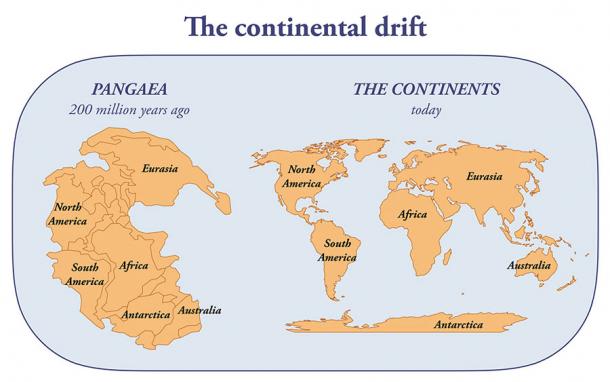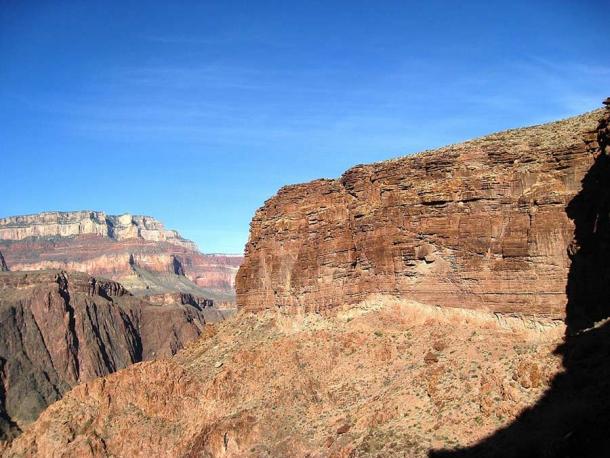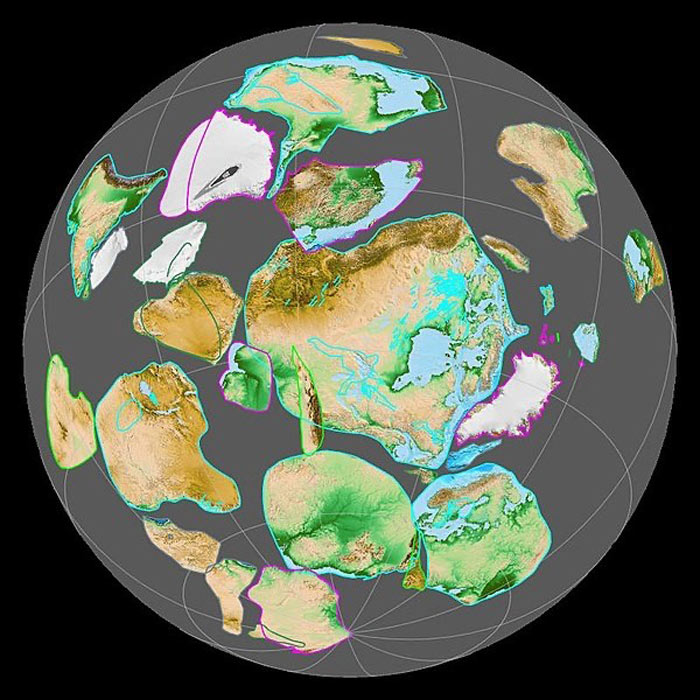The geologic record of Earth’s history is 4.6 billion years long. It contains the history of life on Earth and the formation of the continents and oceans which cover the planet today. There are, however, gaps in this history, usually created by erosion. These are called unconformities. One of the largest of these unconformities is simply called the Great Unconformity. It is called such because as many as 1.2 billion years of Earth’s history are in this gap, about a fifth of our planet’s history. What could have caused this gap? One possibility is erosion related to the breakup of an ancient supercontinent known as Rodinia.
Rodinia and the Ebb and Flow of Supercontinents
Explaining the breakup of Rodinia requires a brief review of plate tectonics and the supercontinent cycle. Because the Earth’s crust is broken up into tectonic plates that move against each other, Earth’s continents are constantly moving across the surface. This happens very slowly, so it is too slight to notice on human timescales.
Every few hundred million years, all the continents come together to form a supercontinent before once again drifting apart to become individual continents. The most recent supercontinent was Pangaea, which formed about 250 to 300 million years ago and began to break apart about 205 million years ago. This breakup formed the beginnings of what is now the Atlantic Ocean basin.
The formation of the most recent supercontinent also coincided with an enormous mass extinction, demonstrating the consequences of supercontinent formation and breakup for life on Earth. Pangaea, of course, is not the only supercontinent whose evolution may have influenced the history of life. A much earlier supercontinent is Rodinia, the name which is derived from the Russian word for “homeland.” It began forming about 1.2 billion years ago and started to break up around 750 million years ago.

The continental drift and the evolution of the earth from Pangaea to today. ( Dimitrios / Adobe Stock)
The Assembly and Breakup of Supercontinents
The mechanism behind the assembly and breakup of supercontinents is the movement of the tectonic plates that make up the crust. There are three types of boundaries between tectonic plates: convergent boundaries, where two tectonic plates are colliding, divergent boundaries, where they are being pushed apart, and transform boundaries, where two plates are moving laterally with respect to each other.
There are two types of convergent boundaries, subduction zones and orogenic, or mountain-building, zones. Subduction zones form when there is a collision between two plate margins of oceanic crust, or two plate margins where one margin is made of oceanic crust and the other is made of continental crust.
These two scenarios will result in volcanic island arcs, like the Philippines, and volcanic coastal mountain ranges, like the Cascades in north-western North America, respectively. Collisions between two plate margins of continental crust will form mountain ranges like the Himalayas.
When continents merge to form supercontinents, the zones of contact between the continents will become orogenic zones, meaning that their merger will lead to the formation of mountain ranges. This is because continental crust is too buoyant to be thrust beneath a tectonic plate. Oceanic crust, on the other hand, is denser and can be thrust under a tectonic plate, or subducted. As a result, the continental crust will just get compressed as continental masses are pushed together, creating mountain ranges.
If these mountain ranges get large enough, the pressure within them will build up to such a degree that the heat generated within the mountain range will cause the mountain range to lose strength and begin to “sag.” It is this sagging and flattening out of the mountain range which can eventually lead to the breakup of continental masses, including supercontinents. This process probably began to occur for Rodinia about 750 million years ago and may be part of the formation process behind the Great Unconformity.

The Great Unconformity was first noticed by John Wesley Powell in the Grand Canyon in 1869. It is a gigantic gap in the geologic timeline. (brewbooks / CC BY-SA 2.0 )
Rodinia and the Great Unconformity
Evidence for the Great Unconformity is found all over the world. One location where it is particularly stark, however, is in the Grand Canyon . For example, the Vishnu Schist, metamorphic rock that used to be sandstones and mudstones in an ancient seabed, which is about 1.7 billion years old, lies directly beneath the Tapeats Sandstone, a rock unit representing an ancient beach dating to about 550 million years ago. About 1 billion years appear to be missing from the geologic record in this section of the Grand Canyon stratigraphy. How could the formation of a supercontinent do this?
A paper in Geology, published in 2018, suggests that the reason for this unconformity is massive erosion from Rodinian mountain ranges that formed as large masses of granitic rock from the underlying craton were exhumed, or uplifted and then eroded, about 680 to 850 million years ago. These ages are based on the radiometric dating of zircon crystals.
As these underlying masses of crystalline rock were exhumed, sedimentary and volcanic layers overlying them would have been eroded away, similar to what is seen in the Sierra Nevada today. The granite or granitoid massifs of the Sierra Nevada mountains in California were once overlain by sedimentary and volcanic deposits.
Over millions of years, however, these relatively weak layers have been eroded away to reveal the relatively erosion resistant crystalline rock beneath. This is likely what happened in Rodinia over 680 million years ago. The erosion of these sedimentary and volcanic layers would have created a pause in deposition in these areas and have erased millions of years of geologic history, resulting in the Great Unconformity.

The Appalachian Mountains were formed by the merging of all continents into the supercontinent Pangea. ( Pavlo Vakhrushev / Adobe Stock)
Uniqueness of the Breakup of Rodinia
Although the case for Rodinia being the culprit behind the Great Unconformity is compelling, it does not explain everything. Uplifting and erosion of the sort that happened with Rodinia also happened with other supercontinents, but other supercontinents do not have 1-billion-year unconformities associated with them. What is puzzling is why this did not happen for the other supercontinents. For example, why is a similarly large unconformity not associated with the breakup of Pangaea?
Pangaea formed by a similar mechanism of the continents coming together, forming enormous mountain ranges, the roots of which survive in the form of the Appalachians in the eastern United States, for example. These highly eroded features once formed the base of a mountain range that rivalled the Himalayas in height. While there are undoubtedly unconformities related to the increased erosion rates from the formation of this mountain range, the effect of these unconformities is not as stark as the Great Unconformity.
What is the reason for this difference? This is speculation, but one reason might be due to the presence of plants. The supercontinent of Rodinia formed before the evolution of macroscopic life. There was life on Earth 1.2 billion years ago, but it was microscopic. The most visible expression of life at the time was in the form of stromatolites, a type of reef built by microbial communities that is preserved in the geologic record. Although Earth was covered in a near global ocean at the time, the landmasses on Earth would probably have resembled the surface of Mars, desolate, desert-like, and possibly with a reddish appearance due to the presence of iron oxides.
Vegetation plays an important role in limiting erosion. It is possible that this lack of plants to act as a control on erosion may have made the erosion of material much more significant on the supercontinent of Rodinia. The supercontinent of Pangaea was very desolate itself, but it would have at least had vegetation in some places to slow the erosion. Rodinia, with its possibly Mars-like landscape, would not have had this control and so rivers, wind, and floods may have had much more erosive power than today.
Another significant factor in the geologic history of the ancient supercontinent is that massive glaciations occurred late in its history. It is not entirely understood why, but the breakup of Rodinia seems to have led to a runaway glaciation that may have created a snowball Earth scenario, where much of Earth’s surface was covered in ice sheets.
Glaciers are also known for being very powerful forces of erosion. They move slowly, but over time, they can move significant amounts of sediment and even carve the solid rock of mountain ranges. The enormous glaciations that occurred at the time, coupled with a complete lack of vegetation to act as a check on erosion, could have created an abnormally destructive erosive sequence leading to the Great Unconformity that we see in the rock record. This explanation is speculation of course, but it does fit with what is known of the conditions of Rodinia as opposed to younger supercontinents, such as Pangaea.
Significance of Rodinia and the Great Unconformity
Rodinia, in addition to being geologically important, may also be important for the history of life on Earth. It was off the coast of the fracturing supercontinent that the first multicellular life may have had its start. As the supercontinent of Rodinia began to break up about 750 million years ago, this process would have led to the formation of rifts where heat beneath the crust was pulling the supercontinent apart. Eventually, these rifts would become ocean basins. A possible modern example of this process is the Red Sea, which may be an incipient ocean basin forming between Northeast Africa and the Arabian Peninsula.
The formation of these ocean basins around Rodinia would have led to the formation of passive continental margins, or continental shelves , similar to those seen on either side of the Atlantic Ocean today. This would have allowed for the existence of large shallow seas. It is in these shallow seas that the first multicellular life probably began to evolve.
About 635 million years ago, the first soft-bodied multicellular organisms, meaning organisms without skeletons or exoskeletons, appear in the fossil record. These early soft-bodied organisms are referred to as the Ediacaran biota. About 540 million years ago, after Rodinia had long since broken up, the Cambrian explosion occurred. This led to the rise of the first hard-bodied organisms, or organisms with skeletons and exoskeletons.
The Cambrian explosion represents the emergence of almost all major phyla of animals living today. The Cambrian Period is most famous, of course, for being the age of arthropods (the phylum containing insects, crustaceans, etc.). Although these events in the history of life happened long after the breakup of Rodinia, they probably happened in shallow seas that formed because of the breakup, and thus were a legacy of the ancient supercontinent. Thus, Rodinia and the Great Unconformity may both be associated with the emergence of multicellular life.

Reconstruction of the supercontinent Rodinia 900 million years ago. (Fama Clamosa / CC BY-SA 4.0 )
The Great Unconformity – The Lost Great Library of Life?
There are many unanswered questions regarding the emergence of the first multicellular life. From a geological perspective, many forms of life in the Cambrian appear to have arisen suddenly without much precedent. It appears that much of the record for this early stage in the evolution of multicellular life could be missing. If the millions or even billion years of geologic history represented by the Great Unconformity had not been erased by erosion, would the record be more complete?
I do not believe that this is required to explain the sparse record of multicellular life at the beginning of the Phanerozoic, but the loss of a record of more than 1 billion years of Earth’s history may still significantly impact our understanding of the history of life on Earth. It is possible that the Great Unconformity could represent a geological equivalent to the loss of the Great Library of Alexandria . Just as the loss of that ancient library left unknown the level of knowledge attained in the ancient world, the loss of geological and paleontological information due to the Great Conformity may leave unknown important details about the history of life on Earth.
The Great Unconformity and the Legacy of Rodinia
If you were to be transported in time and space back to the ancient supercontinent of Rodinia, it would be a very unearthly place. There would be no plants or animals and the air would not have sufficient oxygen for you to breath. Rodinia represents a very different Earth from the one with which we are familiar.
Despite this, that utterly alien landmass played a very significant role in the geologic history of our planet, the continents, and maybe even life. In its death throws, it created the Great Unconformity and may have spurred the emergence of multicellular life through the formation of large continental shelves and shallow seas where this life could flourish. In some ways, Rodinia may be responsible for the modern geological and biological world as we understand it.
Top image: Reconstruction of how the supercontinent Rodinia would have looked. Source: Manuel Mata / Adobe Stock
By Caleb Strom
References
Cox, A, and Hart, R. B. 1986. Plate Tectonics: How it Works . Blackwell Scientific Publications.
Burke Museum. No date. “Dance of the Giant Continents” Burke Museum. Available at: https://www.burkemuseum.org/geo_history_wa/Dance%20of%20the%20Giant%20Continents.htm
Bush Heritage. No date. “Stromatolites” in Bush Heritage Australia . Available at: https://www.bushheritage.org.au/species/stromatolites
Daws, R. L., and Daws, C. D. 2013. “ Basics – Orogenies” in Geology of the Pacific Northwest . Available at: https://commons.wvc.edu/rdawes/basics/orogenies.html.
DeLucia, M.S. et. al. 2018. “Thermochronology links denudation of the Great Unconformity surface to the supercontinent cycle and snowball Earth” in Geology, 46(2), pp. 167-170. Available at: https://doi.org/10.1130/G39525.1
Fox, D. 2016. “What sparked the Cambrian explosion?” in Nature, 530 (7590), p. 268. Available at: https://www.nature.com/articles/530268a
Garber, J. 2011. “Chapter 1: Precambrian Rocks of the Grand Canyon” in Big History . Available at: https://watershed.ucdavis.edu/education/classes/files/content/page/Ch1_BigHistory.pdf
Jiao, J., Zou, H., Jia, Y. and Wang, N., 2009. “Research progress on the effects of soil erosion on vegetation” in Acta Ecologica Sinica , 29 (2), pp. 85 – 91. Available at: https://doi.org/10.1016/j.chnaes.2009.05.001
Istanbulluoglu, E. and Bras, R. L. 2005. “Vegetation‐modulated landscape evolution: Effects of vegetation on landscape processes, drainage density, and topography” in Journal of Geophysical Research: Earth Surface , 110 (F2). Available at: https://doi.org/10.1029/2004JF000249
Joel, L. 2018. “Erasing a Billion Years of Geologic Time Across the Globe” in Eos. Available at: https://eos.org/articles/erasing-a-billion-years-of-geologic-time-across-the-globe
Klemetti, E. 2020. “Are We Seeing a New Ocean Starting to Form in Africa?” in Eos. Available at: https://eos.org/articles/are-we-seeing-a-new-ocean-starting-to-form-in-africa
Peace, A.L. et. al. 2020. “A review of Pangaea dispersal and Large Igneous Provinces–In search of a causative mechanism” in Earth-Science Reviews , Vol. 206, p. 102902. Available at: https://doi.org/10.1016/j.earscirev.2019.102902
Sawe, B. E. 2018. “How Were The Islands In The Philippines Formed?” in World Atlas . Available at: https://www.worldatlas.com/articles/how-were-the-islands-in-the-philippines-formed.html
Treiman, A. 2003. “Grand Canyon – The Great Unconformity” in Lunar and Planetary Institute . Available at: https://www.lpi.usra.edu/science/treiman/greatdesert/workshop/greatunconf/
Waggoner B. M. and Collins, A. G. 1994. “The Cambrian Period” in UC Museum of Palaeontology . Available at: https://ucmp.berkeley.edu/cambrian/cambrian.php
Waggoner, B. M. 1998. “The Ediacaran Period” in UC Museum of Palaeontology . Available at: https://ucmp.berkeley.edu/vendian/ediacaran.php
Zhao, G. et. al. 2018. “Geological reconstructions of the East Asian blocks: From the breakup of Rodinia to the assembly of Pangea” in Earth-Science Reviews , 186, pp. 262-286.
Related posts:
Views: 0
 RSS Feed
RSS Feed















 March 27th, 2022
March 27th, 2022  Awake Goy
Awake Goy  Posted in
Posted in  Tags:
Tags: 
















